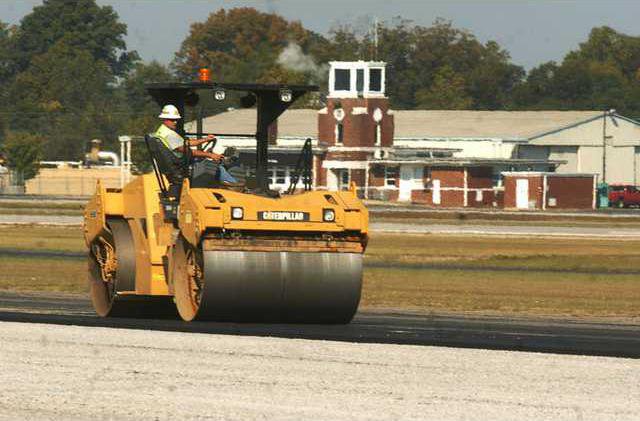Lee Gilmer Memorial Airport is getting a small facelift this week.
Georgia Department of Transportation and Gainesville Public Works crews are repaving the secondary runway, which had old cracks that were refilled for years.
The project, funded by both state and city dollars, was slated to start last year but finally got under way last week.
“State engineers and inspectors looked at the area and weren’t comfortable putting a new surface over the current runway because of the alligator cracks — areas sealed over in tar,” said Chris Rotalsky, assistant director for public works who oversees the airport. “That drove the time frame. We didn’t want to pave last winter and then had some weather delays ... Weather has been great this week and last week.”
Because it is shorter than the primary runway, the secondary runway is only used by smaller planes or during inclement weather when crosswinds on the main runway prevent a pilot from landing. In July, the second runway is also used for the annual Cracker Fly-In, an exhibition of the Experimental Aircraft Association that draws thousands of visitors to see more than 100 planes up close.
“Asphalt, like any road, has a life span, and the runway started degrading and reaching the point where cracking became significant,” Rotalsky said. “We put it in the state program to get on their schedule and keep the airport in the best condition possible.”
Funded 75 percent by state money and 25 percent by city dollars, the $560,000 repaving is the last aviation capital improvement project funded in the state’s budget.
“The state DOT and (Federal Aviation Administration) programs have changed some, and money for aviation may come back around, but that depends on the economy to determine how much will come back,” Rotalsky said. “Because of the timeline shift, state officials said the money for this project was already allocated. Even though, as everyone is aware, we’re in tough budget times, the state saw value in this project and the completion of it.”
Under the repaving guidelines, paving crews mill down the old asphalt, spray wet tar over the runway area, place a layer of gravel to distribute weight of the pavement and then lay the asphalt. On Monday, crews began rolling strips of asphalt down the 4,000-foot runway.
“It’s a quick operation and will probably be complete in about three days. It’s fast paced because we want to open it up as quickly as possible,” Rotalsky said. “After this, another company will come in and paint the markings that guide you on the runway.”
The runway will open again once the initial markings are painted this week. After a month, FAA guidelines require the company to return and paint final markings, which will shut down the runway for a short time.
“A lot goes into a paving project, and the crews are really something else,” Rotalsky said, watching the workers lay the pavement, check the depth and smooth the surface. “It’s neat to see it go from old, cracked asphalt to a smooth track.”

